
Saundaryalahari of Sri Sankaracarya with Transliteration
Book Specification
| Item Code: | IDE071 |
| Author: | Trans. By: Swami Tapasyananda |
| Publisher: | SRI RAMAKRISHNA MATH |
| Language: | Shankaracharya (Sanskrit Text with Transliteration, Translation and Notes based on Laksmidhara's Com |
| Edition: | 2021 |
| ISBN: | 8788171202447 |
| Pages: | 192 |
| Cover: | Paperback |
| Other Details | 7.2" X 4.8" |
| Weight | 140 gm |
Book Description
Saundarya-lahari (or The Inundation of Divine Splendour') is a highly poetical but at the same time a tough technical work of Sri Sankaracarya, who was both the Bhasyskara (commentator) on the Texts of Vedanta philosophy, as also the Sanmata-sthapaka (the founder of the systems of worship of the six Deities of the Hindu pantheon). While this Text is a hymn of praise of the Divine Mother known as Tripurasundari. Lalita, Sodasi, etc., in Her creative aspect, it also deals with the technicalities of Sri Cakra and its worship according to the Samaya tradition. Besides being a highly poetical composition, it is also a Mantra Sanstra, the source of many Mantras used in the adoration of the Divine Mother for the attainment of various blessings of life.
The very recitation of this hymn is considered as many to be an adoration of the Divine. The present book will be helpful to such devotees in understanding the meaning of its verses through an English translation and Notes based on the commentary of Laksmidhara on the hymn.
The Translator Swami Tapasyananda (1904-1991) was a disciple of Swami Shivanandaji Maharaj, one of the eminent disciples of Sri Ramakrishna. The Swami was a vice-president of the Ramakrishna Order from 1985-1991. He was an erudite scholar in Indian and Western philosophy. He has to his credit many books in English, including the translations of many scriptures. His translation of Srimad Bhagavatam in four volumes has been highly acclaimed in intellectual and devotional circles.
Swami Tapasyananda of the Ramakrsna Math has rendered a signal service to the cause of Sakti worship by bringing out this excellent edition of the famous Text, the Saundaryalahari, with the original in Sanskrit, its transliteration, English translation and elaborate notes, for the benefit of the English-knowing public.
The meaning of the dictum 'Truth is Beauty and Beauty Truth' is expounded in the hundred verses of the Saundaryalahari. What is described as 'Santam-Sivam-Advaitam' in the Upanisad, is revealed here as the ultimate perfection of beauty and its adoration.
The origin of Saki worship can be traced to such Vedic texts as Sri-Suktam, Durga-Suktam, Bhu-Suktam, Bahvrcopanisad, Tripuropanisad, Bhavanopanisad and other Devi Upanisads. In Sandhya Upasana, we think of Gayatri Devi in the solar orb and imagine that the sun shines by Her effulgence and that She is also the Truth which has kindled the light of reason in our minds. Her praise is sung thus in the Mantra, 'Ayatu Varada Devi': "To those who adore Thee, O Mother, Thou grantest all boons. Thou art the origin of the Vedas and of all the worlds. Be pleased to shine in my heart and accept my adoration. Thou art effulgence. Thou art the light of the Devas and Thou art in everything and beyond everything. Bathe me in Thy light and purify me." A little reflection will thus show that the daily Sandhyavandana enjoined by the Vedas is primarily Sakti Worship in many contexts. Before entering the Matsya kingdom for spending the last year of exile incognito, Dharmaputra prays to Durga. At the commencement of the battle of Kuruksetra Sri Krsna asks Arjuna to get down from the chariot and to pray to Durga, and Arjuna does so.
In most of the Puranas, the importance of Sakti worship is alluded to. In the Srimad bhagavatam, we see Rukmini worshipping at the shrine of Ambika before her marriage. The Devi Bhagavatam deals entirely with the glory of the Divine Mother. The Brahmanda Purana contains Lalita Sahasranama and Trisati with detailed instructions regarding modes of Devi worship. Candi or Devi Mahatmyam forms part of Markandeya Purana. Then we have the vast literature consisting of Agama, Rahasya, Samhita, Yamala, Arnava and Tantra with their numerous commentaries which codify the methods of Sakti worship and explain its philosophy. Referring to the Sakta Tantras, which are sixty four in number; the Saundaryalahari says that after Siva had filled the world with the other Tantras, He gave out, at the request of Devi, the Sri Tantra which fulfils the objects covered by all the other Tantras, and this is known as the worship of Tripura or Sri-Vidya.
We are told that Dattatreya, seeing that the Upasana of Tripura is considered the highest of all modes of worship and that its effects includes the benefits of the other modes too, composed the Datta-Samhita, comprising 18,000 verses in which the worship of Tripura is laid down in all its details. From him, Parasurama learnt the Samhita and abridged it in the form of 6,000 Sutras. His pupil, Sumedha, made an abridgement of the Samhita and the Sutras in the form of a dialogue between Datta and Rama. It is this abridgement that is known as Parasurama Kalpa Sutra. Sakti worship in the South is mainly on the lines laid down therein. Umanandanatha, a disciple of Bhaskararaya, composed in 1775, the Nityotsava, clarifying the methods of worship according to the Sutra. A later scholar, Ramesvara Sastri, a disciple of Bhaskararaya, wrote a succinct gloss of the sutra by name 'Saubhagya-Subhodaya. Bhaskara-raya himself in his book called 'Setu-bandha,' which is a commentary on Nitya-sodasikarnava of Vamakesvara Tantra, and also in his Lalita-sahasranama Bhasya and Varivasya Rahasya has expounded the methods and philosophy of Sakti worship. These three works of Bhaskararaya are considered the Prasthana Traya of Sri-Vidya.
The worship of Devi in Sri-Cakra is set forth by Adi Sankara in his Prapancasara and Saundaryalahari, and this form of worship occupies a high place in the traditions of the Maths organized by him. In Tamil, we have expositions of Sakti Mantras and Upasanas in 'Tirumantram' of Tirumoola Nayanar and in later day works like 'Abhirami-Antadi.' The works of Arthur Avalon in English have thrown a flood of light on Sakta philosophy and practice and removed misconceptions, which prevailed previously. The writings of Sri Aurobindo and his followers have also contributed to a better understanding of the subject. Kavyakantha Ganapati Sastri, a disciple of Sri Ramana Maharsi, has written a book of Sutras called Dasa-Maha-Vidya or the worship of Kali, Tara, Sundari, Bhuvaneswari, Bhairavi, Chinnamasta, Dhumavati, Bagala, Matangi and Kamala tmika. The Guhananda Mandali in Madras and Kamala tmika. The Guhananda Mandali in Madras has done pioneering work in recent times in removing the cobwebs that had gathered round the Sakta Cult and in popularizing it in its pure form.
Numerous are the places of Sakti worship. Sakti is adored as Uma in the Himalaya, as Amba in Kasmir, as Visalaksi in Varanasi, as Gauri in Kanya Kubja, as Bhavani in Maharastra and as Kali in Calcutta. At Kanya Kumari, the southern extremity of Bharta Varsa, Sakti is worshipped as Bala, in Madhrai as Minaksi, Mantrini or Syamala, at Jambukesvaram as Akhilandewsvari or Dandini, and at Kanchipuram as Kamaksi or Maha-Tripurasundai. She is worshipped as Sarada at Sringeri, as Camundevari in Mysore and Bhagavati in Kerala. On the outskirts of each town and village in South India, she is worshipped as Bhadrakali in unpretentious temples as the guardian deity or Ellayamman, animal sacrifice being permitted there in olden days. She is adored as Durga-Laksmi-Sarasvati (three in one) generally during Navaratri, in every household. In what ever form She is invoked, She is One, the Maha-maya or Parabrahma-Mahisi. Sankaracarya says in Saundaryalahari: "O Parabrahmamahisi! The knowers of Veda call you Vak-Devata the consort of Brahma, Laksmi the consort of Visnu, and Parvati the consort of Siva. But Thou art the Fourth (Turiya) of inconceivable and limitless majesties the indeterminable Mahamaya who revolves the wheel of this world.
Though there are striking differences between the practices and modes of worship of Sakti followed in the North and the South of India, the two are not contradictory, but complementary. Pointing to the tepid gore that flowed from the decapitated trunks of goats at the Kali Temple of Kalighat, Calcutta, a western lady disciple asked Swami Vivekananda, "Well, Swami, why so much blood?" Swamiji gravely replied: "Is not a little necessary to complete the picture?"
Even in the worship of Sri Krsna, we can trace these two approaches. Krsna is not merely 'Vengugopala' or 'Gopijana-Vallabha' with a flute on his lips and a garland on his neck, but is also Kala the Destroyer. In the Visvarupa of the Lord, Arjuna sees His terrible form. The Lord does not say, "I will not send you misfortune", but He says that He would give the strength to bear them when they come. In fact, He seems to have reserved the greatest trials for His dearest devotees. The hero can face the world with all its terror and hideousness and not curse God for it. He looks upon the sweet smile as well as the dark frown on Nature as the manifestations of the same Divinity. God is not only the Lord of creation but also the Lord of destruction. His divine hand is everywhere, in birth as well as in death, in health as well as in disease, in peace as well as in pitchy darkness of a cold wintry night. The sweet smile as well as the angry frown, both beling to the same God. It is therefore said in the Devi Mahatmayam, she is Goddess Laksmi reigning in the house of the fortunate and She is again the ill luck in the house of the sinner. She is the intelligene of the wise, the Sraddha of the pious and the modesty of the virtuous woman.
In the Southern cult of Sri-Vidya the Divine Mother is mostly worshipped in Her aspect as Lalita Maha-Tripura-sundari. The Devi is to be meditated upon as of a ruddy complexion, with eyes expansive as an ocean overflowing with waves of grace, with a noose, a goad, arrows of flowers and a bow of sugarcane in Her hands, surrounded by Anima and other deities, and ultimately as one's own self. The process of worship consists of Bhuta-Suddhi, several kinds of Nyasa, Prana-pratistha, Japa, Manasa-puja, Avarana-puja, Arcana, Dhupa, Diparadhana, Naivedya, Nirajana, Stotra, Kamakala-dhyana, Home, Balidana, Suvasini-puja, Samayika-puja and Tatva-sodhana. The worship is done in the image of the Devi as well as in the Sri-Cakra otherwise known as Sri-Yantra.
Mantra, Yantra and Tantra form the three corners of the triangle of Sri-Vidya. Mantra is visualized in the Yantra. The worship of the Yantra, internal and external, and the practice of Kundalini Yoga and other Sadhanas constitute the Tantra or modus operandi. The chief Mantra or sri-Vidya is Panca-dasaksari and the chief Tantra is the meditation on the identity of Mantra, Yantra and Tantra with the Devi Herself. If Sakti worship is done with understanding and appreciation and with love in the heart, then Mantra, Yantra, offerings, the procedure and paraphernalia of Puja are all transformed into forms and expressions of Cit-Sakti. The object is to effect the transformation of the materials and acts of ordinary experience into forms revealing the play, the power and the bliss of the Divine Mother. The Saundaryalahari says that if the worshipper practices Atmarpanam, ordinary talk is converted into japa, normal work with the hand becomes Mudra, walking becomes Pradaksina, eating becomes Homa, lying down Pranama- in fact whatever action is naturally done is transformed into worship.
The Sri-Vidya Upasaka should follow certain disciplines. He should not find fault with other paths or criticize them. While being steadfast in his own. The practice of japa should go on as an under current at all times. He should not aks for favours or accept them. He should do his duties in the world and the worship of the Deity without attachment to fruit. He should be fearless. He should not acquire wealth and possessions with the motive of selfish enjoyment and he should consider nothing as higher than realization of the Self.
Sakti worship properly understood is a synthesis and harmony in which diverse and sometimes conflicting tendencies of human endeavour have been accommodated and each in union with the rest has been assured its fullest development and satisfaction. An adept in Sri-Vidya can be a Sakta at heart, a saivite in outlook and a Vaisnavite in practice. That such reconciliation is not only possible but also necessary was revealed to us in Sri Ramakrsna, the Avatara Purusa of the age. He has proved that all paths pursued with devotion lead to the one God, that Mantras are efficacious, that Yantras are potent, that devatas and higher powers exist, that Siddhis to come and that step by step the Divine Mother leads the Sadhaka to higher and higher levels of perfection till he reaches the goal.
Sri Ramakrsna says: "That which is Brahman is also Kali, the Mother, the Primal Energy. When inactive, It is called Brahman. Again, when creating, preserving, and destroying It is called Sakti. Still water is an illustration of Brahman. The same water, moving in waves, may be compared to Sakti or Kali. What is the meaning of Kali? She who communes with Maha-Kala, the Absolute, is Kali. She is formless and again she has forms. If you believe in the formless aspect, then meditate on Kali as that. If you meditate on any aspect of Hers with firm conviction, She will let you know Her true nature. Then you will realize that not merely does God exist, but He will come near you and talk to you, as I am talking to you. Have faith and you will achieve everything."
The ultimate Reality is Sat-Cit-Ananda, Existence-Con-sciousness-Bliss. The Essence in man is identical with this Reality but under the influence of Maya, he has forgotten his ture nature. He takes to be real a merely apparent world of subject and object, and this error is the cause of his bondage and suffering. The goal of all spiritual practice is the rediscovery of his true identity with the Reality. For the achievement of this goal Vedanta prescribes an austere method of discrimination and renunciation. The way is, 'Neti Neti', to negate the Asat or unreal Upadhis. If the Upadhis are eliminated through service to a Guru and proper enquiry, one realizes the identity of the Jivatman and Paramatman. But this is not so easily done. Sri Krsna says in the Bhagavad Gita, "The difficulty of those whose thoughts are set on the unmanifested is greater, for the goal of the unmanifested Brahman is hard to reach for embodied beings (who are attached to their bodies)." Sri Ramakrsna says, "It is God Himself who makes us feel this difference, and on account of this difference, one sees man and woman, light and darkness, and so on. As long as one is aware of this difference, one must accept Sakti the Personal God. It is God who has put 'I-consciousness' in us. You may reason a thousand times; still this 'I' does not disappear. Therefore, as long as a man is conscious of 'I' and of differentiation, he cannot speak of the attributeless Brahman but must accept Brahman with attributes. This Brahman with attributes has been declared in the Vedas, the Puranas, and the Tantra, to be Kali, the Primal Energy." This is the justification for combining philosophy with rituals and meditation with ceremonies. Whereas the Vedantic method of enquiry is one of rejection and elimination, the Tantric method is one of acceptance and sublimation. Sakti worship is a means of elevation of the consciousness, using even based materials as help, following the lead of one who has tried the experiment before and succeeded. The very poison that kills is transmuted into the elixir of life. In the process of worship, the order in which the Tattvas are evolved is reversed. From the gross, one proceeds to the subtle, from the outer Bhupura of the Sri-Cakra to the Bindu, the central point. By this practice one is enabled to awaken the Kundalini sakti lying coiled in the Muladhara, at the base of the spinal column. Kundalini is a universal principle. Having evolved the complex apparatus of every object, Kundalini coils herself up at the center of the apparatus and remains at the static, nuclear basis and also as its magazine of power to draw and fall back upon. One must help oneself by drawing from this power to become free from the bonds under which one groans. Even if one does not consciously or deliberately set oneself to the task of rousing the Kundalini, She will be roused by the power of Bhakti or Jnana and by the disciplines of the Upasana one practices, if one follows them with faith. This was demonstrated in the life of sri Ramakrsna. He actually saw the power ascending along the Susumna Canal and the six centers to the thousand petalled lotus at the top of the head. This phenomenon was accompanied by visions and trances. Later on, he described to his disciples and devotees the various movements of the Kundalini, fish-like, bird-like, monkey-like, and so on. The awakening of the Kundalini is the beginning of spiritual consciousness, and its union with the Supreme spirit in the Sahasrara is the consummation of Sakti worship.
Swami Tapasyanandaji has explained with great lucidity the philosophical background of Saundaryalahari, clearly showing the difference in some of the philosophic conceptions of the Samaya and Kaula forms of sakti worship. The present publication is an invaluable addition to Sakta literature, which is the field of practical religion.
There are several other translations of the Saundaryalahari in English, but most of them are out of print or beyond the reach of ordinary readers. The Text is highly technical, but yet many, especially in South India, recite it as a matter of pious religious duty, without understanding its meaning. The object of this work is to give to such devotees an intellectual understanding of its meaning intellectual only, because it deals with the highly technical subject of the Uapsana(adoration) of Sri Vidya, which can be performed only by one who is initiated into it by a representative teacher of an authentic tradition of the Vidya.
For the benefit of those who do not know Devanagari, we have given the translation of the verse in Roman script with diacritical marks. The sound equivalents of the letters having diacritical marks are given in a table. The hyphens given in the Devanagari script have no grammatical sgnificance, nor do they indicate any stop of continuity while reading. They are given only for making it easy for reading by those who are not very familiar with this script.
The Notes are based mainly on the most recondite commentary on the Text by Laksmidhara, who was a great scholardevotee attached to the Court of the Maharaja Gajapati-Vira-Pratapa-Rudra, who ruled in Cuttack, Orissa, during 1466-1539. The views of some who differ from him on some important points are also given here and there in the Notes.
We are very much indebted to Sri Anna. N. Subramanian of the Ramakrishna Mission Student' Home, Madras, for the very profound and meaningful Foreword he has given to this book, and for going through the manuscript and the proofs also. He is a well-known teacher of the Vidya and is very through with the subject in its theoretical and practical aspects. But for the very substantial help given by him through a careful scrutiny of the Introduction, Notes and Translation, we would have felt great hesitation in bringing out this book which deals with a highly technical work of the great Sri Sankaracarya.
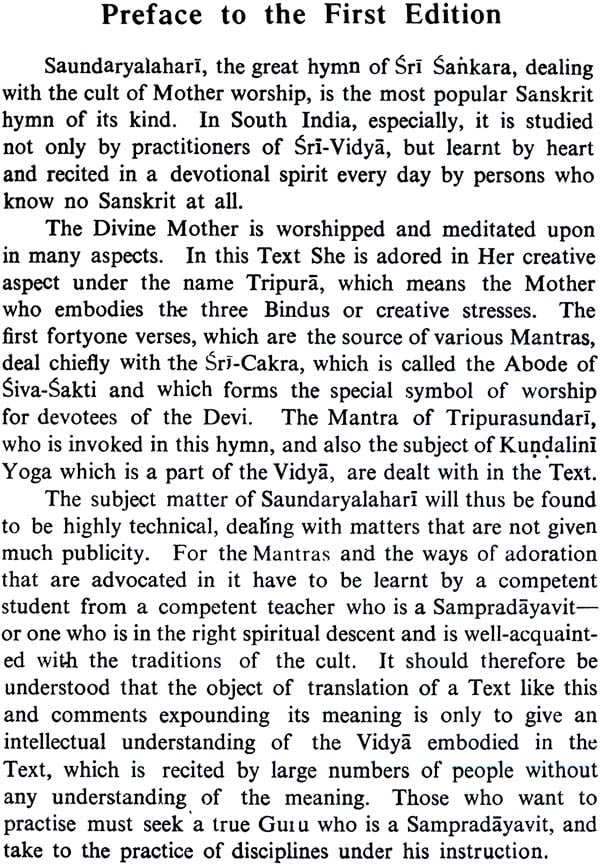

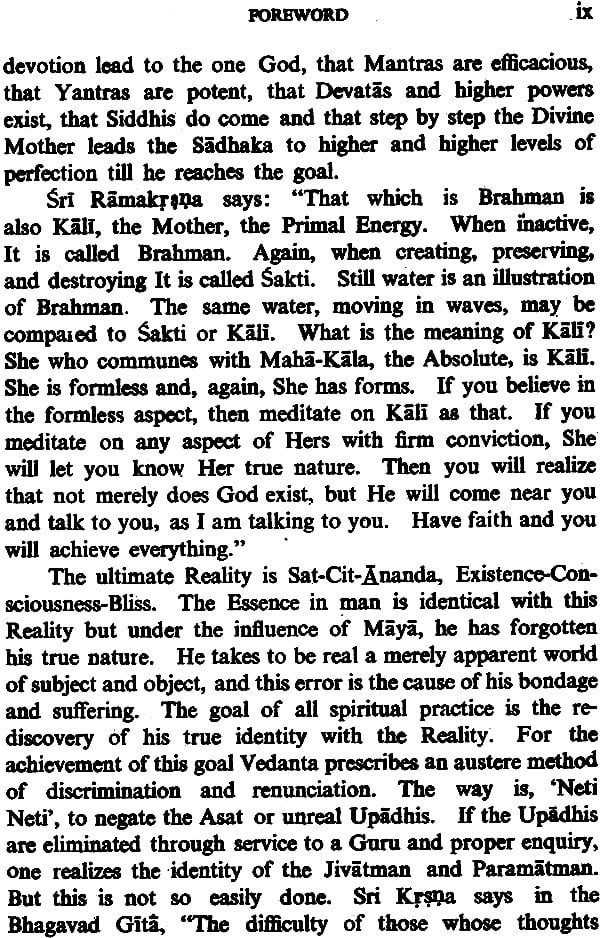
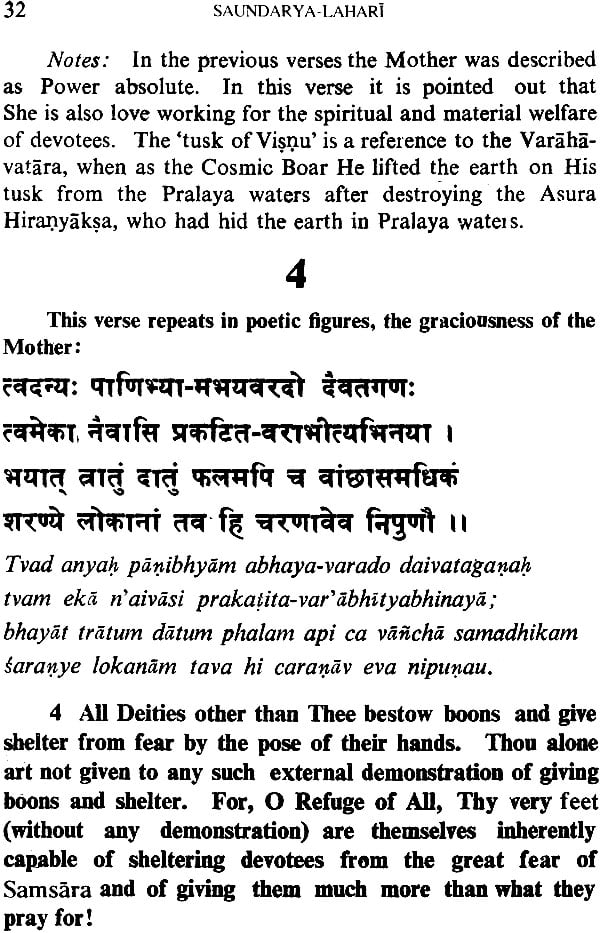
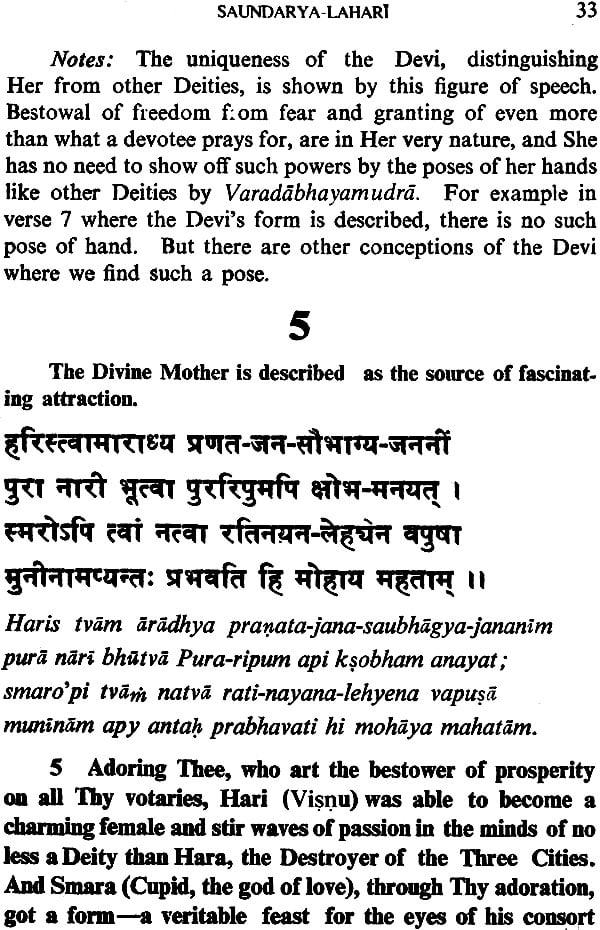
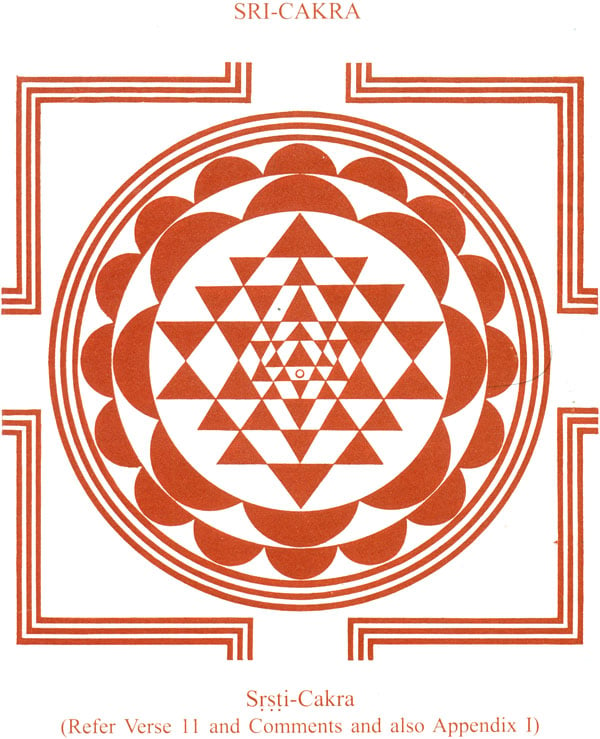
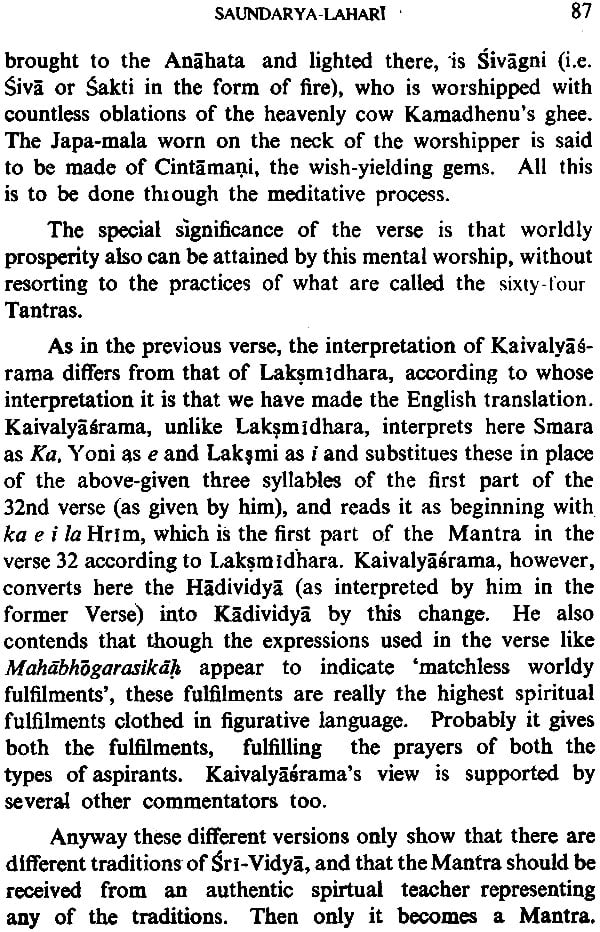
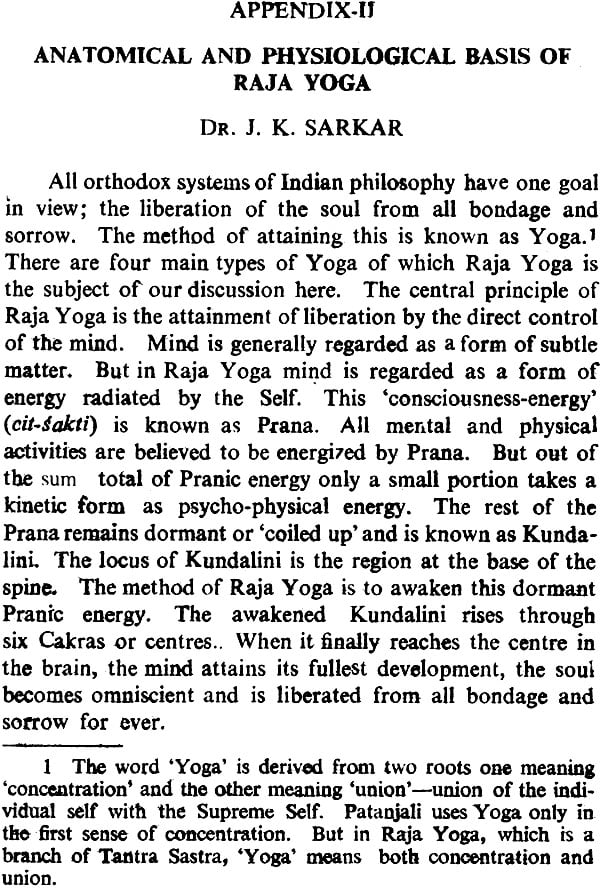
Of Related Interest:
Life of Shankaracharya - The Adventures of a Poet Philosopher
Click Here for an Exhaustive Collection of Books Relating to Shankaracharya





